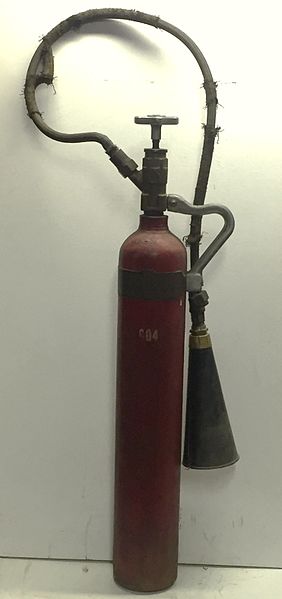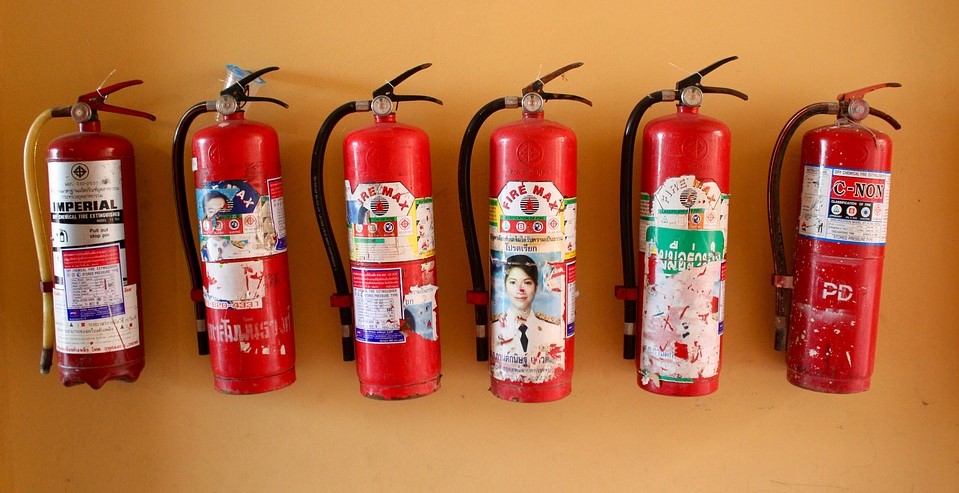Fire extinguisher
Contents |
[edit] Introduction
Fire extinguishers are portable apparatus used to put out small fires in emergency situations. They work by distributing a suitable extinguishant (such as liquid, foam, powder and so on) onto the burning material to cut off its supply of oxygen or suppress the chemical reaction occurring in the flame.
[edit] History
The earliest forms of fire extinguisher were introduced in the Middle Ages. These devices, known as squirts, were pump-like devices with nozzles on the end.
The nozzle of the pump would be put into water, and a plunger would be used to pull the water into the squirt. The nozzle was then aimed at the fire, and the water stream would be directed towards the fire.
In 1723, Ambrose Godfrey was awarded the first official patent for a fire extinguisher. The German-born British chemist was best known for his production of phosphorus, but in 1724, he published a document entitled ‘New Method of Extinguishing Fires by Explosion and Suffocation’. His idea was to design a machine consisting of a cask of an aqueous solution surrounding a pewter chamber of gunpowder. The idea behind this was that a series of fuses would be detonated which would then make the gunpowder explode and distribute the liquid.
The first portable fire extinguisher was invented in 1819 by Captain George William Manby. His device consisted of a copper vessel containing a solution of potassium carbonate and compressed air.
Other early examples included:
- 1866 sodium bicarbonate and sulphuric acid with water
- 1904 chemical foam of sodium bicarbonate and aluminium sulphate.
- 1912 carbon tetrachloride (CTC).
- 1924 carbon dioxide.

|
| The 1924 carbon dioxide extinguisher invented by the Walter Kidde Company was made to put out fires in telephone switchboards. The device consisted of a metal cylinder with a wheel valve and a brass hose covered with cotton. The extinguisher in this photograph was made by the Walter Kidde Company for Bell Telephone in 1928. |
[edit] Fire extinguisher categories
In the UK, fire extinguishers are included in the standard BS EN 3 - Portable fire extinguishers. The extinguishers are colour coded to indicate which type of fires they should be used to extinguish:
- Water = Red
- Foam = Red with cream panel above the operating instructions
- Dry powder (generally a mix of monoammonium phosphate and ammonium sulfate, but not for combustible fires) = Red with blue panel above the operating instructions
- Carbon dioxide = Red with black panel above the operating instructions.
- Wet chemical (generally containing potassium acetate with potassium citrate or potassium bicarbonate) = Red with a bright yellow panel above the operating instructions.
- Class D powder (generally a mix of monoammonium phosphate and ammonium sulfate, but only for combustible fires) = Red with blue panel above the operating instructions.
[edit] Six fire classes
The UK recognises six fire classes:
- Class A fires involve organic solids such as paper and wood.
- Class B fires involve flammable or combustible liquids, including petrol, grease and oil.
- Class C fires involve flammable gases.
- Class D fires involve combustible metals.
- Class E fires involve electrical equipment/appliances.
- Class F fires involve cooking fat and oil.
| Class A | Class B | Class C | Class D | Class E | Class F | |
| Water | Yes | |||||
| Foam | Yes | Yes | ||||
| Dry powder | Yes | Yes | Yes | Yes | ||
| Carbon dioxide | Yes | Yes | ||||
| Wet chemical | Yes | Based on situation | Yes | |||
| Class D powder | Yes |
While the powder inside fire extinguishers is non-toxic, contact should be limited. Precautions should be taken to minimise incidents where these circumstances could occur.
[edit] Maintenance
Fire extinguishers should be checked and maintained on a regular basis. While it’s uncommon for a device to have an expiration date, its reliability can degrade over time if it has not been properly maintained.
In the UK, there are three types of required maintenance:
- Basic. Annual service and inspection
- Extended. Five year test discharge and recharge.
- Overhaul: 10 year test for CO2 extinguishers.
[edit] Related articles on Designing Buildings Wiki
Featured articles and news
Professional practical experience for Architects in training
The long process to transform the nature of education and professional practical experience in the Architecture profession following recent reports.
A people-first approach to retrofit
Moving away from the destructive paradigm of fabric-first.
International Electrician Day, 10 June 2025
Celebrating the role of electrical engineers from André-Marie Amperè, today and for the future.
New guide for clients launched at Houses of Parliament
'There has never been a more important time for clients to step up and ...ask the right questions'
The impact of recycled slate tiles
Innovation across the decades.
EPC changes for existing buildings
Changes and their context as the new RdSAP methodology comes into use from 15 June.
Skills England publishes Sector skills needs assessments
Priority areas relating to the built environment highlighted and described in brief.
BSRIA HVAC Market Watch - May 2025 Edition
Heat Pump Market Outlook: Policy, Performance & Refrigerant Trends for 2025–2028.
Committing to EDI in construction with CIOB
Built Environment professional bodies deepen commitment to EDI with two new signatories: CIAT and CICES.
Government Grenfell progress report at a glance
Line by line recomendation overview, with links to more details.
An engaging and lively review of his professional life.
Sustainable heating for listed buildings
A problem that needs to be approached intelligently.
50th Golden anniversary ECA Edmundson apprentice award
Deadline for entries has been extended to Friday 27 June, so don't miss out!
CIAT at the London Festival of Architecture
Designing for Everyone: Breaking Barriers in Inclusive Architecture.
Mixed reactions to apprenticeship and skills reform 2025
A 'welcome shift' for some and a 'backwards step' for others.






















